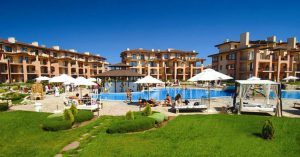

Yaylata is a unique corner of the Black Sea coast. It lies in the northeast of the Gulf of birds between the head of Shabla and Kaliakra majestic head, about 1.5 km south of Kamen Bryag. “Yailata” is a picturesque place, which topographical is a half-km terrace carved into the steep and rocky shores, extremely difficult to access by sea and by land.
Here are nesting and passes for wintering, to the shores of Africa over 178 species of birds. There are also registered more than 270 species of animals. Some of the most interesting are: the medium Cormoran / Aristotelis Phalacrocorax /; the Great bustard / Otis tarda Linnaeus /; Bustard small strepet/ Tetrax Tetrax /; monk sea/ Monachus Monachus / etc. Via Pontica is the second migratory route of “charge” of the Europe, after Gibraltar, in Spain. By Via Pontica migration corridor are passing most of the birds from Europe and Asia. Via Pontica passes along the Black Sea coast of Bulgaria, including Yailata and Cape Kaliakra. Here are nesting and passing for witnering to the lakes of Africa more than 178 species of birds..
The nature of this place is rich and interesting..
Yailata landslide is large, terraced, with a length of about two kilometers. The three sliding clearly distinguishable steps and of different sizes, are actualy huge rocks, slipped into the sea on top of a clay in slope. Their upper parts are pushed onto land and from the sea are separated from each other by a steep area, almost vertical. With the greatest length of approximately 1,300 m and a width of about 200 m is the main step, the lower one.
On the Yailata rocks at different heights, there are about 40 caves, rock shelters and many niches. The coast is dotted with numerous boulders and rocks.
In its limestone steep cliffs, waves hitting the shore modeled several caves with water, like the seal’s one, the blue one and Galabovo, whose entries are about 8 m below the sea level.
Yailata is relatively inaccessible by land, except for a few hard crossed paths among the rocks. Today, it still retains its wild beauty, its terraced floors are covered with dense vegetation from early spring until late autumn. The view is spectacular in spring when the wild irises and peonies bloom in Yailata, poppies, cornflowers, daisies and more. The population of this region is called pasture “Yayla”, hence the name of the zone.
It is a habitat for many animals – foxes, rabbits, hedgehogs, turtles, lizards, snakes. For seabirds Yailata is a paradise. The caves are inhabited by cave pigeons, bats and other invertebrates, and in the marine waters are living the large fish- turbot, bluefish, mullet, catfish and others.
It is curious that the natural protection of Yailata attracted people from ancient times. During excavations in the cave were found valuable artifacts and materials from different historical eras.
Particularly interesting are the rock tombs. The oldest dates back 8,000 years. For Yailata preservation as an extremely rich archeological monument, it was declared an archaeological reservation in 1989.
One of the legends about “Yailata”, says that here the Roman poet Ovidius spent his last days, exiled in the city of Tomis (now Constanța) by the Emperor Augustus. After his escape from Tomis, it has been housed in the Gulf Yailata where it was hidden by locals.





